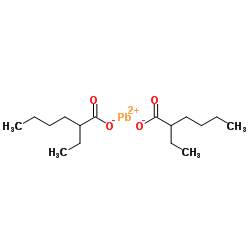301-08-6
| 中文名 | 2-乙基己酸铅 |
|---|---|
| 英文名 | Lead bis(2-ethylhexanoate) |
| 中文别名 | 异辛酸铅 |
| 英文别名 |
Lead(2+) bis(2-ethylhexanoate)
EINECS 206-107-0 2-Ethylhexanoic acid lead(II) salt LEAD(II) 2-ETHYLHEXANOATE Lead bis(2-ethylhexanoate) MFCD00014003 |
| 密度 | 1.56 |
|---|---|
| 沸点 | 228ºC at 760mmHg |
| 分子式 | C16H30O4Pb |
| 分子量 | 493.60700 |
| 闪点 | 116.6ºC |
| 精确质量 | 494.19100 |
| PSA | 80.26000 |
| LogP | 1.52460 |
| 储存条件 | 室温 |
| 计算化学 | 1.疏水参数计算参考值(XlogP):无 2.氢键供体数量:0 3.氢键受体数量:4 4.可旋转化学键数量:8 5.互变异构体数量:无 6.拓扑分子极性表面积80.3 7.重原子数量:21 8.表面电荷:0 9.复杂度:93.9 10.同位素原子数量:0 11.确定原子立构中心数量:0 12.不确定原子立构中心数量:2 13.确定化学键立构中心数量:0 14.不确定化学键立构中心数量:0 15.共价键单元数量:3 |
| 更多 | 一、物性数据 性状:不可用 密度(g/mL,25/4℃):1.56 相对蒸汽密度(g/mL,空气=1):不可用 熔点(ºC):不可用 沸点(ºC,常压):不可用 沸点(ºC,5.2kPa):不可用 折射率:不可用 闪点(ºC):162 比旋光度(º):不可用 自燃点或引燃温度(ºC):不可用 蒸气压(kPa,25ºC):不可用 饱和蒸气压(kPa,60ºC):不可用 燃烧热(KJ/mol):不可用 临界温度(ºC):不可用 临界压力(KPa):不可用 油水(辛醇/水)分配系数的对数值:不可用 爆炸上限(%,V/V):不可用 爆炸下限(%,V/V):不可用 溶解性:不可用 |
|
Section 1: Product Identification Chemical Name:Lead (II) 2-ethylhexanoate (40.5-42.5% Pb) CAS Registry Number:301-08-6 Formula:Pb[OOCCH(C2H5)C4H9]2 EINECS Number:none Chemical Family:metal carboxylate Synonym:lead-2-ethylcaproate, 2-ethylcaproic acid, lead salt.
Section 2: Composition and Information on Ingredients IngredientCAS NumberPercentACGIH (TWA)OSHA (PEL) Title Compound301-08-6100%0.05mg/m30.05mg/m3 Section 3: Hazards Identification Harmful by inhalation and if swallowed. May cause harm to the unborn child. Danger of cumulative effects. Emergency Overview: Possible risk of impaired fertility. May cause cancer, Primary Routes of Exposure:Ingestion, skin, inhalation of dust. Eye Contact:May cause slight to mild irritation of the eyes. Skin Contact:The dust may cause slight to mild irritation of the skin. Inhalation:Harmful by inhalation. Large dust exposure may cause seizures, coma, and cardio respiratory arrest. Harmful if swallowed. Ingestion of dust may lead to dizziness, abdominal cramps, vomiting, bloody diarrhea, Ingestion: weakness, and convulsions. Acute Health Affects:Harmful by inhalation and if swallowed. May cause harm to the unborn child. Danger of cumulative effects. Possible risk of impaired fertility. May cause cancer. The chronic effects include diarrhea, loss of appetite, Chronic Health Affects:insomnia, weakness, muscle pain, headache, dizziness, anemia. The subject of chronic lead poisoning can not be adequately addressed in this document. NTP:No IARC:No OSHA:No SECTION 4: First Aid Measures Immediately flush the eyes with copious amounts of water for at least 10-15 minutes. A victim may need Eye Exposure: assistance in keeping their eye lids open. Get immediate medical attention. Wash the affected area with soap and water. Remove contaminated clothes if necessary. Seek medical Skin Exposure: assistance if irritation persists. Remove the victim to fresh air. Closely monitor the victim for signs of respiratory problems, such as difficulty Inhalation: in breathing, coughing, wheezing, or pain. In such cases seek immediate medical assistance. Ingestion:Seek medical attention immediately. Keep the victim calm. Give the victim water (only if conscious). SECTION 5: Fire Fighting Measures Flash Point:324°F Autoignition Temperature:none Explosion Limits:none Extinguishing Medium:carbon dioxide, dry powder or foam If involved in a fire, fire fighters should be equipped with a NIOSH approved positive pressure self-contained Special Fire Fighting Procedures: breathing apparatus and full protective clothing. Hazardous Combustion andIf involved in a fire this material may emit toxic organic fumes and toxic lead oxide dust. Decomposion Products: Unusual Fire or Explosion Hazards: No unusual fire or explosion hazards. SECTION 6: Accidental Release Measures Spill and Leak Procedures:Small spills can be mixed with vermiculite or sodium carbonate and swept up. SECTION 7: Handling and Storage Handling and Storage:Store in a sealed container. Keep away from heat and moisture. SECTION 8: Exposure Controls and Personal Protection Eye Protection:Always wear approved safety glasses when handling a chemical substance in the laboratory. Skin Protection:Wear appropriate chemical resistant gloves and protective clothing. Ventilation:If possible, handle the material in an efficient fume hood. Respirator:No respirator required. Ventilation:If possible, handle the material in an efficient fume hood. Additional Protection:No additional protection required. SECTION 9: Physical and Chemical Properties Color and Form:viscous liq. Molecular Weight:493.61 Melting Point:no data Boiling Point:no data Vapor Pressure:no data Specific Gravity:1.56 Odor:none Solubility in Water:insoluble SECTION 10: Stability and Reactivity Stability:air and moisture stable solid Hazardous Polymerization:no hazardous polymerization Conditions to Avoid:none Incompatibility:oxidizing agents Decomposition Products:Carbon dioxide, carbon monoxide, organic vapors, and toxic lead oxides and carbonates. SECTION 11: Toxicological Information RTECS Data:No information available in the RTECS files. Carcinogenic Effects:Carcinogen (as Pb) Mutagenic Effects:No data available Tetratogenic Effects:Reproductive effector (as Pb) SECTION 12: Ecological Information Avoid release to groundwater or waterways. Very toxic to aquatic organisms. May cause long-term adverse Ecological Information: effects. SECTION 13: Disposal Considerations Disposal:Dispose of according to local, state and federal regulations. SECTION 14: Transportation Shipping Name (CFR):Non-hazardous Hazard Class (CFR):NA Additional Hazard Class (CFR):NA Packaging Group (CFR):NA UN ID Number (CFR):NA Shipping Name (IATA):Non-hazardous Hazard Class (IATA):NA Additional Hazard Class (IATA):NA Packaging Group (IATA):NA UN ID Number (IATA):NA SECTION 15: Regulatory Information TSCA:Listed in the TSCA inventory. SARA (Title 313):Title compound: See Category Code N420 for reporting. Second Ingredient:none SECTION 16 - ADDITIONAL INFORMATION N/A |
|
毒理学数据: 二、毒理学数据: 急性毒性:不可用。 生态学数据: 三、生态学数据: 1、其它有害作用:该物质对环境可能有危害,对水体应给予特别注意。
|
| 危害码 (欧洲) | Xn |
|---|---|
| 风险声明 (欧洲) | 20/22-33-61-62 |
| 安全声明 (欧洲) | S45-S53 |
| 危险品运输编码 | UN 2291 |
| 包装等级 | III |
| 危险类别 | 6.1 |


